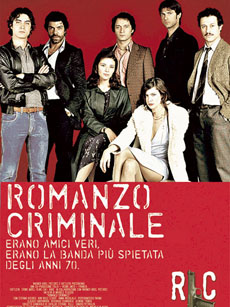Interview with Michele Placido
For many months, even before shooting began, word in the Italian film industry was that the subject and the genre of Romanzo Criminale were "in Michele Placido’s mind’s eye". How and how much did you rely on that mind’s eye?
I mostly find my mind’s eye thanks to the screenwriters, Rulli and Petraglia, with whom I have collaborated on some important work during my career both as an actor and a director, from “Mery forever”, to a chapter of “La Piovra”, from Amelio’s “Lamerica” to “Pummarò”, and even earlier with “Un eroe borghese”, a film I directed which was inspired by Italian news reports and that you could say was a social film. This was when I worked on the Ambrosoli crime, here too there was an aspect that was relevant to the Italian events of the time – the end of the seventies and all of the eighties - with the disturbing ties between Mafia, acts of terrorism and the many secrets of the Secret Service. So, I was already familiar with the subject matter and I found Cattleya’s proposal to go back and look at a piece of Italian history from the perspective of a gang of criminals, fascinating.
Romanzo Criminale is a “gangster movie” that describes a period of national political and civil turbulence. An action movie that uses “close-ups”, the most powerful and moving technique in film, to convey the story of the rise and fall of a group of criminals in the capital. Are there genres and filmmakers that influenced you in your filming of these “goodfellas”?
To tell this kind of story, Luca Bigazzi, the director of photography, and I focused on passions, emotional ones, asking ourselves what kind of style, language and techniques to use to describe them. Everything has changed in Rome today from the period that we are describing: buses, cars, shop signs, street panels. Bigazzi suggested we tighten the field of vision to contain the space of the shots, and use close-ups to make the emotions of the characters come out. This is how the psychology of the protagonists emerge, which of course necessitated great actors in order to work. And it seems to me that really everybody, all the actors, were up to the task, essential for success, they all “got into character”, it would have been a disaster if we had gotten them wrong. For models, I looked at, or a better way to describe it, absorbed, that part of our cinematic history that spans from Leone to Pasolini, not like models to imitate, but as inspiration to find individual solutions for shooting. The direction and the standard is not that of important American cinema, even Scorsese and Tarantino have admitted more than once that they watched our films from the seventies, I am talking about certain B action movies, those with Tomas Milian and Maurizio Merli, tough films, violent action films, that reckoned with a reality that was probably just as hard, a bit paranoid and dominated by suspicion. What we did was bring to the screen the truly violent, ruthless crimes committed by that “Roman school” of delinquency.
A lot of good is often said about the actor work of directors who are themselves actors with lots of experience. It can appear like an ideal, almost idyllic rapport. In this film your actors include almost the entire national team of La Meglio GioventĂą (The Best of Youth). How did you guide each of them? Was there a group spirit, a virile cohesion that in its core reflects the essence of the film, that of the crew of the gang?
I think so, there was the cohesion and spirit of the group, but also a challenge for each to be better than themselves. There is no lead role, no absolute protagonist. Before shooting started, there were those who would have preferred less known faces, the faces of criminals, not celebrities. Actually, the actors in the gang (Santamaria, Favino, Rossi Stuart) are all real Romans, like many in the supporting roles. They all did a lot of research, studying images and reading newspaper articles from the period, as well as devouring De Cataldo’s novel. Their “Romanness” was essential even if the story is only inspired by, and is not the actual account of an extremely dangerous gang in the capital. I think that Stefano Accorsi deserves a special mention for the difficult role of Officer Scialoja, the ambiguous role as a character who is hostile and unlikable. I think it was a trial of his maturity as an actor. Even the two women are emblems of Roman femininity, Anna Mougalis, the prostitute and Jasmine Trinca, the good girl who is capable of redeeming a criminal. With Anna’s character I wanted to show a very refined prostitute, like the girls in Mauro Bolognini’s “La notte brava”, elegant, slender, gaunt. I like to remind people that Mouglalis is not only the face of Chanel, but also an actress who attended the Consèrvatoire de Paris, the equivalent of our Accademia d'Arte Drammatica. Instead, Jasmine incarnates tenderness, the purity of the soul, a clean conscience and intellectual courage.
 Print
Print














